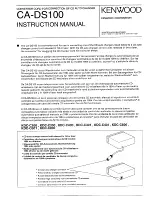
6-8
Cisco Security Appliance Command Line Configuration Guide
OL-12172-03
Chapter 6 Adding and Managing Security Contexts
Configuring a Security Context
You can enter these commands multiple times to specify different ranges. If you remove an allocation
with the
no
form of this command, then any context commands that include this interface are removed
from the running configuration.
Transparent firewall mode allows only two interfaces to pass through traffic; however, on the ASA
adaptive security appliance, you can use the dedicated management interface, Management 0/0, (either
the physical interface or a subinterface) as a third interface for management traffic.
Note
The management interface for transparent mode does not flood a packet out the interface when that
packet is not in the MAC address table.
You can assign the same interfaces to multiple contexts in routed mode, if desired. Transparent mode
does not allow shared interfaces.
The
mapped_name
is an alphanumeric alias for the interface that can be used within the context instead
of the interface ID. If you do not specify a mapped name, the interface ID is used within the context. For
security purposes, you might not want the context administrator to know which interfaces are being used
by the context.
A mapped name must start with a letter, end with a letter or digit, and have as interior characters only
letters, digits, or an underscore. For example, you can use the following names:
int0
inta
int_0
For subinterfaces, you can specify a range of mapped names.
If you specify a range of subinterfaces, you can specify a matching range of mapped names. Follow these
guidelines for ranges:
•
The mapped name must consist of an alphabetic portion followed by a numeric portion. The
alphabetic portion of the mapped name must match for both ends of the range. For example, enter
the following range:
int0-int10
If you enter
gigabitethernet0/1.1-gigabitethernet0/1.5 happy1-sad5
, for example, the command
fails.
•
The numeric portion of the mapped name must include the same quantity of numbers as the
subinterface range. For example, both ranges include 100 interfaces:
gigabitethernet0/0.100-gigabitethernet0/0.199 int1-int100
If you enter
gigabitethernet0/0.100-gigabitethernet0/0.199 int1-int15
, for example, the command
fails.
Specify
visible
to see physical interface properties in the
show interface
command even if you set a
mapped name. The default
invisible
keyword specifies to only show the mapped name.
The following example shows gigabitethernet0/1.100, gigabitethernet0/1.200, and
gigabitethernet0/2.300 through gigabitethernet0/1.305 assigned to the context. The mapped names are
int1 through int8.
hostname(config-ctx)#
allocate-interface gigabitethernet0/1.100 int1
hostname(config-ctx)#
allocate-interface gigabitethernet0/1.200 int2
hostname(config-ctx)#
allocate-interface gigabitethernet0/2.300-gigabitethernet0/2.305
int3-int8
Summary of Contents for 500 Series
Page 38: ...Contents xxxviii Cisco Security Appliance Command Line Configuration Guide OL 12172 03 ...
Page 45: ...P A R T 1 Getting Started and General Information ...
Page 46: ......
Page 277: ...P A R T 2 Configuring the Firewall ...
Page 278: ......
Page 561: ...P A R T 3 Configuring VPN ...
Page 562: ......
Page 891: ...P A R T 4 System Administration ...
Page 892: ......
Page 975: ...P A R T 5 Reference ...
Page 976: ......
















































